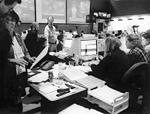The only Y2K disaster to hit anywhere on the planet was Seattle’s: a public relations one. As billions partied, Seattle took on the role of the Millennium’s biggest hick town as international broadcasts showed the peoples of the world partying their asses off.
It was the broadcast version of a world’s fair. At the site of our own, all was fenced and quiet. Throughout the day, Seattle Center was a ghost town as Seattleites and our overcautious, Schell-shocked city fathers found it more convenient to hunker, rather than party, down. On New Year’s Eve, the Space Needle spouted a few fireworks at midnight, but even that paled in comparison to other “world class” cities like Sydney (to which we’re often compared). Hell, it couldn’t match Bill Gates’ private display in Medina. In short, between our WTO cock-up and New Year’s nervousness, we managed to demonstrate just how un-world class (thank goodness) we are. It’s ironic that it took a booster like Paul Schell to finally get that message across.
The mayor is satisfied that no calamities occurred on his watch. But the odd fact is, no calamities occurred on anyone’s watch. And nothing symbolized that better than the Y2K bug itself.
Let me step back for a moment for a Seattle Weekly I-told-you-so. Here is the conclusion of Fred Moody’s story pooh-poohing the Y2K bug in our June 18, 1998 issue: “When I look ahead . . . I see . . . a spree of revisionist articles as one reformed alarmist . . . after another weighs in with his analysis of the Millennium Bug That Wasn’t.” At that time, Moody and the Weekly took enormous loads of crap from people who didn’t believe our Y2K scenario, which was this: the problems are relatively minor and fixable—if we take the money and the time, it will be no big deal.
For those interested in buying stock in Fred Moody, he has now left the Weekly for some kind of high-tech start-up. And while he undoubtedly spent New Year’s planning how to spend his new stock options, I spent it visiting a couple of Y2K emergency centers, searching for an apocalypse that never came.
Camp Murray, just south of Tacoma near Fort Lewis, is a monument to disaster. It is the pastoral home base for the state’s National Guard and the office of Emergency Services, whose job is to be ready when the shit hits the fan. Just inside the gate is a little memorial park with plaques commemorating the Guard’s response to various disasters, including wars, floods, power outages, and Mt. St. Helens. Just outside is a diner called “Galloping Gertie’s,” which shares the name of one of Washington’s most memorable filmed fiascos: the bucking collapse of original Tacoma Narrows bridge.
I show up for a 10:30am briefing and a tour of the State Year 2000 Coordination Center. A few press jam into a small room to hear whether any Y2K weirdness is happening anywhere in Washington. The only thing reported is a downed Bonneville power line carrying electricity from Washington to California. Over 100 miles south of The Dalles (translation: middle of nowhere), someone had pulled the bolts out of a few guywires and a transmission tower fell over. “Was it Alergerian anarchists from Eugene?” one wag asks. Everyone laughs. The FBI is investigating, but it looks like everyday vandalism. Via phone, a power company spokesperson reports that there had been a small outage in Tumwater that morning. Did customers wonder if it was the dread Y2K in their backyard? The spokesperson doesn’t think so. Another pipes in with what could be the slogan for the entire day: “There is no panic in Tumwater.”
The most impressive thing I see at Camp Murray is the state’s Emergency Operations Center, a modern-looking box sitting on giant springs that supposedly will keep it from collapsing during a millennial earthquake. For the time being, it’s home to the state’s Y2K watch for “rollover weekend.” Inside is a large room filled with computers, giant TV screens, and about 50 staffers, mostly flacks from various state agencies. They are monitoring the status of water, sewer, power, transportation, government services, food, etc., in every county using a new national Internet database that the feds created just for Y2K. If there was panic in Tumwater, or if the toilets weren’t flushing in Humptulips, they’d know it here.
When we enter for our press tour, an announcement is made: “Sanitize your screens!” They’re not worried about our health; I suspect they just don’t want us to see any confidential reports that might be flashing in. Chris Long, assistant EOC supervisor, is a big ex-military guy with a shaved head. He seems to personify the kind of fellow you’d want in your fox hole. He shows us around, including introducing us to an elderly ham radio volunteer who is standing by in case all other forms of communication fail (no sign of carrier pigeons). When not stalking the dread Y2K bug, the EOC folk actually do real things that impact real lives, like coordinate search and rescue operations. A couple of the press photographers spot one of the Y2K team with his feet up on the desk and jostle for position to get an emblematic shot. Chris rolls his eyes. You spend a career saving lives and the media want to shoot one state employee on break.
Maybe they wanted their screens “sanitized” from us.
That night, I visit the ROC (Regional Operations Center) in Bothell, where the Federal Emergency Management Agency (FEMA) is monitoring reports from every state and around the world. Representatives from the FBI, Coast Guard, GAO, ATF, and GSA are manning the center around the clock. Everyone’s ensconced in a low building that was built in the 1960s as a bombproof civil defense facility.
I’ve checked radio and TV and discovered no Y2K disaster has hit anywhere in the world. I figure, though, that FEMA might have some inside scoop. (The Militia of Montana seems to think so; they reported that FEMA trucks were secretly buying out food stocks at selected supermarkets right before New Year’s; a FEMA spokesperson denies this to me.)
A reporter from the Everett Herald and I are given a tour by our media contact, Mike Howard, who enthusiastically tells us about FEMA’s force of on-call helpers, some of them former journalists like us, who go to disaster trouble spots on a moment’s notice and get victims back on their feet by telling them how the government can help. Most of the trips, he says, are to spots in posthurricane Florida where you get to stay in storm-damaged four-star hotels.
We are briefed by FEMA’s regional director, David deCourcy. When I ask—almost plead—with him to tell us if there’s anything anywhere in the world being reported on Y2K foul-ups, he says that they did receive a report that the government in Gambia was having some trouble with its accounting system—but it’s not clear that it is Y2K related.
We talk about whether or not there is any future use for the government’s Y2K reporting system, and he says that one joker suggested they keep it in place and change its name to Y3K. Bureaucracy is made, after all, to last 1,000 years. He says that there will be an “after action” report addressing the future of the reporting system and the fancy multimillion-dollar world-monitoring Y2K center in Washington, DC.
Since FEMA is already thinking about post-apocalypse “after action” reports and the only global threat is a glitch in Gambian spreadsheets, I realize it is well past time to go home, drink champagne, and toast the bug that never bit.







